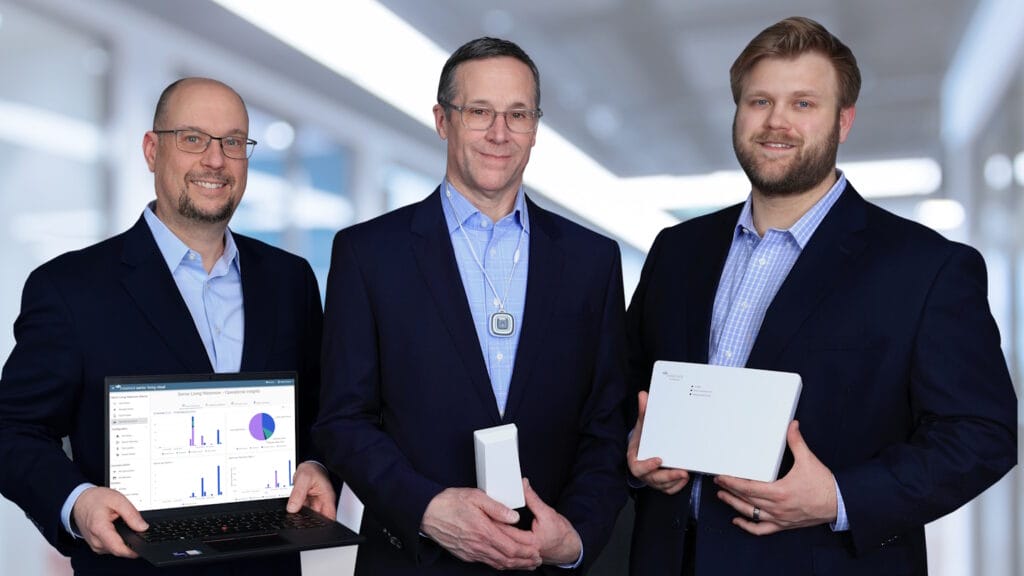
Partner content
The evolution of senior living care needs
For decades, resident alarm pendants have been the cornerstone of safety in senior living. Providing independence and peace of mind, they have evolved along with the needs of the industry. The first electronic nurse call systems were deployed in the 1970s, featuring bulky pendants connected to landlines. Though they were limited in functionality, they offered a lifeline to senior living residents fearing falls or medical emergencies. In the following years, pendants became smaller and more comfortable and wireless technology was introduced to allow increased mobility and independence, but the underlying technology remained much the same.
In the twenty-first century, the senior living industry faces a set of challenges that call for a new evolution in technology. Labor shortages and staff turnover, in combination with a growth in the aging population, are driving the need for solutions that enable greater efficiency for overworked staff. The age and frailty of the population entering assisted and independent living care settings is also increasing as seniors delay entry due to lower savings rates. This trend demands an innovation in pendant solutions that can improve response times, getting staff to the right place as quickly as possible.
The evolution of alarm pendant hardware
Meeting the contemporary challenges of the senior living industry requires a new kind of pendant solution, as well as the associated infrastructure. Like the earliest pendants, the ability to trigger alarms with a button press is invaluable. However, pendants containing sensors to automatically detect falls can help ensure residents receive care when a resident is unable to press the button.
Because pendants are wearables and falls and medical emergencies can happen anywhere within the building, caregivers may have no way of knowing with confidence where the fall or emergency is occurring. In communities facing staffing shortages, every minute counts, and location accuracy can help to enable faster response times and support better resident outcomes.
Because indoor location isn’t feasible or cost-effective using GPS satellite technology, a better solution is needed. Indoor location typically consists of pendants equipped with 2.4 GHz location technology, a series of locators placed throughout the community, and a gateway device to manage the alarm and location information.
One of the primary advantages of this type of system is that the infrastructure can be used to enable other efficiency technologies. For instance, staff badges with location technology can allow caregivers to be located when they are needed. The same with medical equipment such as wheelchairs and medication carts which can be equipped with location-enabled asset tags.
In the words of Garrett Hoffman, Product Manager of Hardware at Inovonics, “We’re doubling down to make sure we are addressing all the well-known use cases for location in senior living.”
The evolution of alarm pendant software
Enabling the full functionality of the pendant requires a cloud-based solution. Handling the amount of data necessary to track the location of staff, assets, and residents, as well as the associated alarms, would be nearly unworkable in a legacy system, and incredibly costly if it were attempted.
Moreover, a cloud-based solution enables new functionality. As opposed to a system that simply reports location at the exact instant of an alarm, the cloud allows for location determination in near real-time. This allows staff to quickly find a resident for medication administration and visits by family members and outside service providers. Leveraging the cloud, pendants can also help to track activity, allowing caregivers to look for changes that signal improvement or decline to get ahead of changing care needs. In the same way, they can send alerts about unusual or urgent events that can signify distress, such as approaching a restricted area, visiting the bathroom at unusual times or leaving the room at odd hours.
Most importantly, this advanced location technology opens the door for future applications that can meet the emerging needs of residents, caregivers and communities. As Kevin Hardy, Inovonics’ Senior Product Manager of Software, says, “Technology really does two things for us: It makes us more efficient at our tasks, and gives us a greater degree of accuracy, making us less prone to error.”
Conclusion
From their beginnings as landline-connected emergency buttons to the sophisticated smart pendants of today, these devices continue to adapt and evolve, reflecting the changing needs of an aging population and the possibilities of technology. As we look towards the future, it’s clear that alarm pendant solutions will continue to play a vital role in shaping a future where seniors can live longer, healthier, and more fulfilling lives.
At Inovonics, we are continually developing solutions leveraging advanced technology that allow you to easily upgrade your trusted e-call system with new features, capabilities and insights that support better resident outcomes and increased efficiency.
For more information, contact our partners at: https://wireless.inovonics.com/mcknights
Written by: Todd Stanley, Strategic Growth Platform Manager for Senior Living at Inovonics, with contributions by: Kevin Hardy, Senior Product Manager of Software at Inovonics, and Garrett Hoffman, Product Manager of Hardware at Inovonics.

